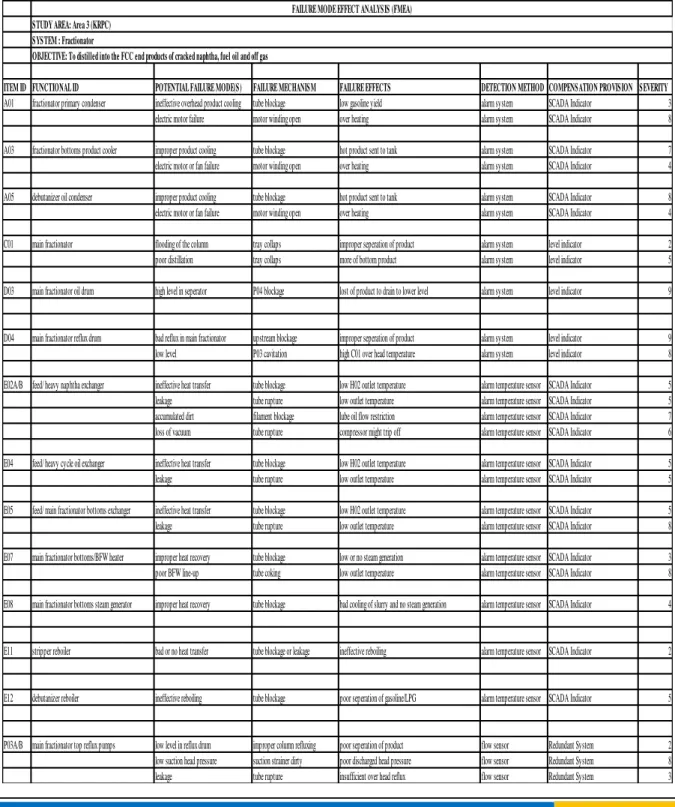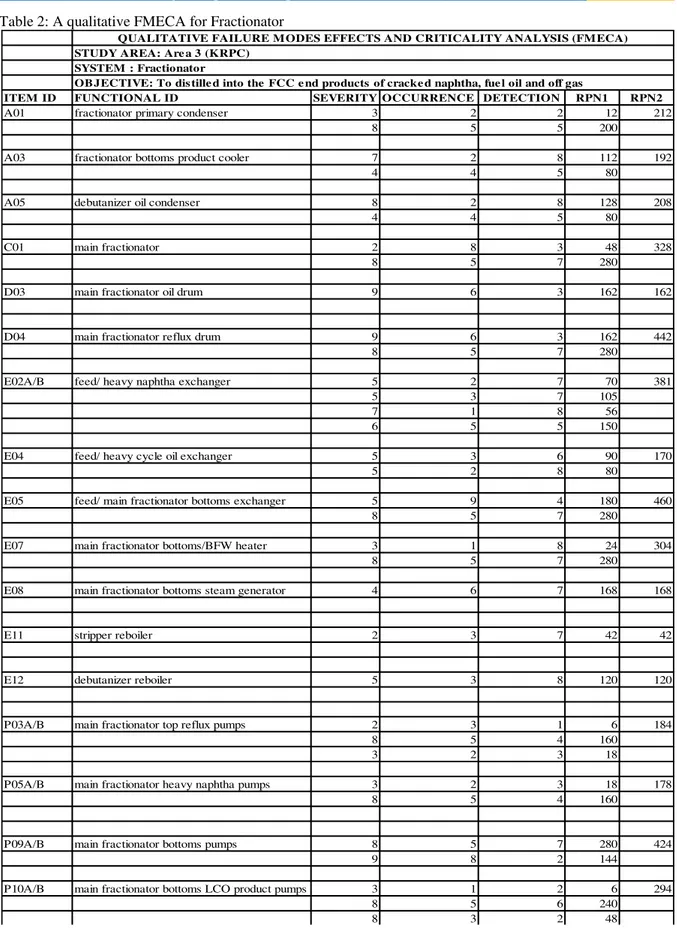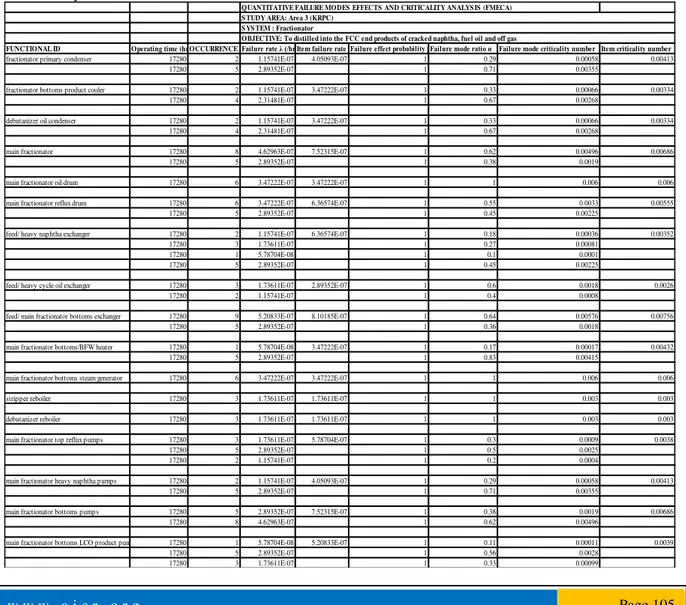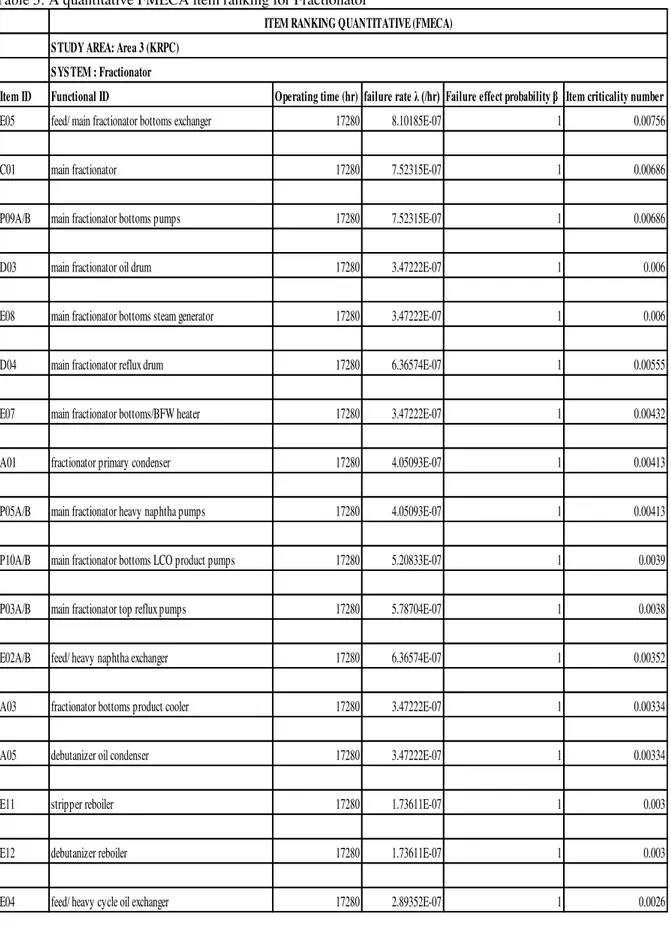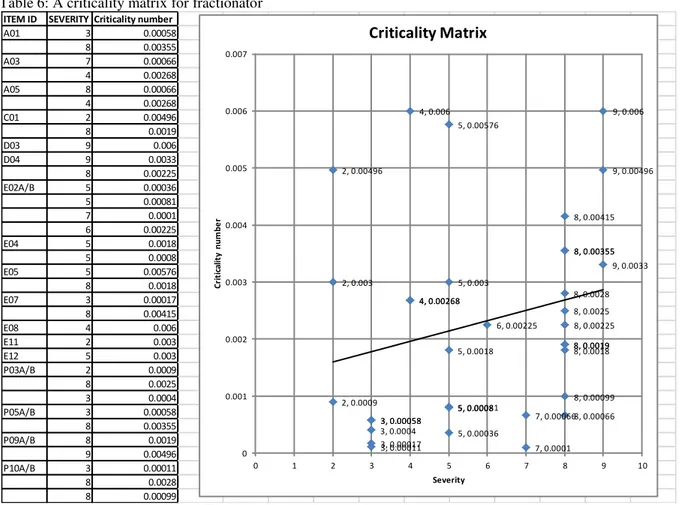American Journal of Engineering Research (AJER)
2016
American Journal of Engineering Research (AJER)
e-ISSN: 2320-0847 p-ISSN : 2320-0936
Volume-5, Issue-2, pp-101-108
www.ajer.org
Research Paper Open Access
Assessment of the Reliability ofFractionator Column of the
Kaduna Refinery using Failure Modes Effects and Criticality
Analysis (FMECA)
Ibrahim A.
1and El-Nafaty U. A
21,2
Department of Chemical Engineering, Abubakar Tafawa Balewa University, Bauchi State, Nigeria.
Abstract
—The reliability of a process equipment is the probability that an item will perform a required function under stated condition(s). It is an important issue in any process industry. Failure to assess the reliability of most process equipment had led to huge financial losses. As a result, this research aims at assessing the reliability of the Fractionator column of the Kaduna Refining and Petrochemicals (KRPC), Fluid Catalytic Cracking Unit (FCCU), using the Failure mode, effects and criticality analysis (FMECA). The failure mode effects analysis (FMEA) was firstused to identify failure modes, mechanisms, cause, effects severity of the fractionator column through its fourteen (14) sub-units(fractionator primary condenser, bottoms product cooler, debutanizer oil condenser, main fractionator, main fractionator oil drum, main fractionator reflux drum, heavy naphtha exchanger, heavy cycle oil exchanger, bottoms exchanger, BFW heater, steam generator, stripper reboiler, debutanizer reboiler, top reflux pumps). Both quantitative and qualitative criticality analyses (CA) were used to determine the effectiveness and reliability of the unit (Fractionator column). For the qualitative analysis, items risk priority number (RPN) were computed and it was found that, six (6) of the sub-units (feed/ main fractionator bottoms exchanger, main fractionator reflux drum, main fractionator bottoms pumps, feed/ heavy naphtha exchanger, main fractionator, and main fractionator bottoms/BFW heater) had their RPN>300, with feed/ main fractionator bottoms exchanger having the highest RPN of 460. For the quantitative analysis, items criticality number (Cr) were computed and it was found that most of the sub-units had their Cr>0.002. In addition, the results of the criticality matrix showed that, fifteen (15) out of the twenty nine (29) failure modes identifiedwere above or closely below the criticality line. Therefore, the effectiveness and reliability of the unit is low. As such, sub-units with RPN>300 and failure modes above or closely below the criticality line were recommended for replacement or predictive maintenance.Keywords
—
FCCU; Fractionator column; reliability; FMEA/FMECA; risk priority number, criticality number; and criticality matrix.I
.
INTRODUCTIONInformation gained by performing FMECA can be used as a basis for troubleshooting activities, maintenance, manual development and design of effective built-in test techniques[6].The analysis is characterized as consisting of two sub-analyses, the first being the failure modes and effects analysis (FMEA), and the second, the criticality analysis (CA).The method is widely used and accepted throughout the military and commercial industries [7].This tool was used by Ibrahim, A. et’al[8], 2015 to assess the reliability of a Reactor – regenerator unit. Their result showed that the reliability of the unit was found to be low. Similarly, Thangamani, G. et’al[9]
, 1995used this tool to assess the reliability of a FCCU. Also, Flecher, P[10]. 2012 used this tool to assess the risk of Sinopec X’ian branch FCCU. His result showed that reactor-regenerator systems have the highest potential hazard. In addition, Mahendra, P[4]. 2012 apply FMECA for ensuring reliability of process equipment. At the end of his work, highly critical systems and failure modes were identified and that the duration for which the equipment is out of work is reduced significantly. Similarly, Masoud. H. et’al[11] 2011 in their research “The application of FMEA in the oil industry in Iran: The case of four litre oil canning process of Sepahan Oil Company”. The aim of their research was to show how FMEA could be applied to improve the quality of products at Sepahan Oil Company.However, after implementation of the improvement actions from FMEA, the can scrap percentage was reduced from 50000 to 5000 ppm and the percentage of the oil waste was reduced from 1 to 0.08%. Therefore, the use of FMECA to assess the reliability of FCCU will help to minimize huge financial loses as a result of equipment failure.
II. Methodology
FMEA was used to identify potential failure modes, failure mechanism, failure effects, detection method, compensation provision and severity of the reactor-regeneration unit. The FMEA data were generated from the failure logbooks, operating manuals, equipment maintenance manuals and questionnaires. After FMEA analysis, both quantitative and qualitative criticality analysis (FMECA) were performed. According to Ibrahim, A. et’al[8], 2015, Keller, P[12]. 2014, and RAC[13] 2005 equations (1), (2), (3) and (4) were used for the quantitative criticality analysis, while according to Puthillath, B. et’al[14] 2012, Yelmaz, M[15]. 2009, Sydney Water [16]2010 and Sultan, L.L[6]. 2011 equation (5) was used for the qualitative analysis.
�= ∗ ∗ λ�∗ − − − − − − − − − − − − − − − − − − − − − − − − − − − − − − − − − − − − 1
Where,
α is the failure effect probability
α= λ�
λ − − − − − − − − − − − − − − − − − − − − − − − − − − − − − − − − − − − − − − − − −(2)
λ = λ�
�=1,2,3…
− − − − − − − − − − − − − − − − − − − − − − − − − − − − − − − − − − − − −(3)
β is the failure mode ratio
λ� is the failure rate
λ� = ���� � ��� ��� ��� � − − − − − − − − − − − − − − − − − − − − − − − − − − − − − − − − − −
− −(4) t is the operating time
= ∗ ∗ − − − − − − − − − − − − − − − − − − − − − − − − − − − − − − − − − − − −(5)
Where,
D is the detection O is the occurrence S is the severity
A criticality matrix was then computed from the plot of criticality number and severity using MS-Excel spread sheet. This was used to identify critical items which were then ranked according to their level of criticality.
III. Results and Discussion
failure which may cause minor injury, minor property damage, or minor system damage which will result in delay or loss of sub-unit (marginal), to a failure which may cause death or lack of ability to carry out operation without warning (catastrophic). This values and description of the failures above were in conformity with the RAC[13], 2005 and Technical manual[17], 2006. Table 2 represents the qualitative FMECA for the fractionator unit. From the Table, six (6) sub-units (main fractionator, main fractionator reflux drum, heavy naphtha exchanger, main fractionator bottom exchanger, main fractionator bottoms/BFW heater and main fractionator bottom pumps) have their RPN greater than 300 these sub-units are critical and have low reliabilities. Eleven (11) of the sub-units (fractionator primary condenser, bottoms product cooler, debutanizer oil condenser, main fractionator oil drum, heavy cycle oil exchanger, steam generator, stripper reboiler, debutanizer reboiler, top reflux pumps, LCO product pump and heavy naphtha pump) have their RPN less than 200. These sub-units are said to be less critical and have moderate reliabilities. Ibrahim, A. et’al[8]2015 and Puthillath, B. et’al[14]
2012 used these methods of RPN to categorize items.
Table 1: A FMEA sheet for Fractionator
ITEM ID FUNCTIONAL ID POTENTIAL FAILURE MODE(S) FAILURE MECHANISM FAILURE EFFECTS DETECTION METHOD COMPENSATION PROVISION SEVERITY
A01 fractionator primary condenser ineffective overhead product cooling tube blockage low gasoline yield alarm system SCADA Indicator 3 electric motor failure motor winding open over heating alarm system SCADA Indicator 8
A03 fractionator bottoms product cooler improper product cooling tube blockage hot product sent to tank alarm system SCADA Indicator 7 electric motor or fan failure motor winding open over heating alarm system SCADA Indicator 4
A05 debutanizer oil condenser improper product cooling tube blockage hot product sent to tank alarm system SCADA Indicator 8 electric motor or fan failure motor winding open over heating alarm system SCADA Indicator 4
C01 main fractionator flooding of the column tray collaps improper seperation of product alarm system level indicator 2 poor distillation tray collaps more of bottom product alarm system level indicator 5
D03 main fractionator oil drum high level in seperator P04 blockage lost of product to drain to lower level alarm system level indicator 9
D04 main fractionator reflux drum bad reflux in main fractionator upstream blockage improper seperation of product alarm system level indicator 9 low level P03 cavitation high C01 over head temperature alarm system level indicator 8
E02A/B feed/ heavy naphtha exchanger ineffective heat transfer tube blockage low H02 outlet temperature alarm temperature sensor SCADA Indicator 5 leakage tube rupture low outlet temperature alarm temperature sensor SCADA Indicator 5 accumulated dirt filament blockage lube oil flow restriction alarm temperature sensor SCADA Indicator 7 loss of vacuum tube rupture compressor might trip off alarm temperature sensor SCADA Indicator 6
E04 feed/ heavy cycle oil exchanger ineffective heat transfer tube blockage low H02 outlet temperature alarm temperature sensor SCADA Indicator 5 leakage tube rupture low outlet temperature alarm temperature sensor SCADA Indicator 5
E05 feed/ main fractionator bottoms exchanger ineffective heat transfer tube blockage low H02 outlet temperature alarm temperature sensor SCADA Indicator 5 leakage tube rupture low outlet temperature alarm temperature sensor SCADA Indicator 8
E07 main fractionator bottoms/BFW heater improper heat recovery tube blockage low or no steam generation alarm temperature sensor SCADA Indicator 3 poor BFW line-up tube coking low outlet temperature alarm temperature sensor SCADA Indicator 8
E08 main fractionator bottoms steam generator improper heat recovery tube blockage bad cooling of slurry and no steam generation alarm temperature sensor SCADA Indicator 4
E11 stripper reboiler bad or no heat transfer tube blockage or leakage ineffective reboiling alarm temperature sensor SCADA Indicator 2
E12 debutanizer reboiler ineffective reboiling tube blockage poor seperation of gasoline/LPG alarm temperature sensor SCADA Indicator 5
P03A/B main fractionator top reflux pumps low level in reflux drum improper column refluxing poor seperation of product flow sensor Redundant System 2 low suction head pressure suction strainer dirty poor discharged head pressure flow sensor Redundant System 8 leakage tube rupture insufficient over head reflux flow sensor Redundant System 3
FAILURE MODE EFFECT ANALYSIS (FMEA) STUDY AREA: Area 3 (KRPC)
SYSTEM : Fractionator
Table 2: A qualitative FMECA for Fractionator
Table 3 shows the prioritized items for corrective action based on the fractionator RPN. Item with the highest RPN showed item to be considered first for either replacement, repair or maintenance. This is to ensured safety and reliability of the unit. The feed/ main fractionator bottoms exchanger has the highest RPN of 460 this means highest priority for corrective action, the order follows up to stripper reboiler with the least RPN value of 42. This means least priority for corrective action.In terms of selection criteria for maintenance program, Puthillath, B. et’al[14]
2012 also adopted this system of item ranking.
ITEM ID FUNCTIONAL ID SEVERITY OCCURRENCE DETECTION RPN1 RPN2
A01 fractionator primary condenser 3 2 2 12 212
8 5 5 200
A03 fractionator bottoms product cooler 7 2 8 112 192
4 4 5 80
A05 debutanizer oil condenser 8 2 8 128 208
4 4 5 80
C01 main fractionator 2 8 3 48 328
8 5 7 280
D03 main fractionator oil drum 9 6 3 162 162
D04 main fractionator reflux drum 9 6 3 162 442
8 5 7 280
E02A/B feed/ heavy naphtha exchanger 5 2 7 70 381
5 3 7 105
7 1 8 56
6 5 5 150
E04 feed/ heavy cycle oil exchanger 5 3 6 90 170
5 2 8 80
E05 feed/ main fractionator bottoms exchanger 5 9 4 180 460
8 5 7 280
E07 main fractionator bottoms/BFW heater 3 1 8 24 304
8 5 7 280
E08 main fractionator bottoms steam generator 4 6 7 168 168
E11 stripper reboiler 2 3 7 42 42
E12 debutanizer reboiler 5 3 8 120 120
P03A/B main fractionator top reflux pumps 2 3 1 6 184
8 5 4 160
3 2 3 18
P05A/B main fractionator heavy naphtha pumps 3 2 3 18 178
8 5 4 160
P09A/B main fractionator bottoms pumps 8 5 7 280 424
9 8 2 144
P10A/B main fractionator bottoms LCO product pumps 3 1 2 6 294
8 5 6 240
8 3 2 48
QUALITATIVE FAILURE MODES EFFECTS AND CRITICALITY ANALYSIS (FMECA) STUDY AREA: Are a 3 (KRPC)
SYSTEM : Fractionator
Table 3: A prioritized item ranking for fractionator
Table 4 depict the quantitative FMECA for fractionator unit.The data(item failure rates, failure mode ratio, maintainability, and item criticality number) where computed for the fourteen (14) sub-units(fractionator primary condenser, bottoms product cooler, debutanizer oil condenser, main fractionator, main fractionator oil drum, main fractionator reflux drum, heavy naphtha exchanger, heavy cycle oil exchanger, bottoms exchanger, BFW heater, steam generator, stripper reboiler, debutanizer reboiler, top reflux pumps). The criticality number (Cr) showed the level of risk and reliability of each of the sub-unit.The higher the criticality number (Cr) the more risk involve and the lower the reliability of the item. All the sub-units with the exception of heavy cycle oil exchanger have their Cr > 0.003. Similar data were obtained by RAC[13], 2005 and Technical Manual[17], 2006 in assessing the reliability of their defence equipment.
Table 4: A quantitative FMECA sheet for Fractionator
QUANTITATIVE FAILURE MODES EFFECTS AND CRITICALITY ANALYS IS (FMECA)
FUNCTIONAL ID Operating time (hr)OCCURRENCEFailure rate λ (/hr)Item failure rateFailure effect probability βFailure mode ratio α Failure mode criticality number Item criticality number
fractionator primary condenser 17280 2 1.15741E-07 4.05093E-07 1 0.29 0.00058 0.00413
17280 5 2.89352E-07 1 0.71 0.00355
fractionator bottoms product cooler 17280 2 1.15741E-07 3.47222E-07 1 0.33 0.00066 0.00334
17280 4 2.31481E-07 1 0.67 0.00268
debutanizer oil condenser 17280 2 1.15741E-07 3.47222E-07 1 0.33 0.00066 0.00334
17280 4 2.31481E-07 1 0.67 0.00268
main fractionator 17280 8 4.62963E-07 7.52315E-07 1 0.62 0.00496 0.00686
17280 5 2.89352E-07 1 0.38 0.0019
main fractionator oil drum 17280 6 3.47222E-07 3.47222E-07 1 1 0.006 0.006
main fractionator reflux drum 17280 6 3.47222E-07 6.36574E-07 1 0.55 0.0033 0.00555
17280 5 2.89352E-07 1 0.45 0.00225
feed/ heavy naphtha exchanger 17280 2 1.15741E-07 6.36574E-07 1 0.18 0.00036 0.00352
17280 3 1.73611E-07 1 0.27 0.00081
17280 1 5.78704E-08 1 0.1 0.0001
17280 5 2.89352E-07 1 0.45 0.00225
feed/ heavy cycle oil exchanger 17280 3 1.73611E-07 2.89352E-07 1 0.6 0.0018 0.0026
17280 2 1.15741E-07 1 0.4 0.0008
feed/ main fractionator bottoms exchanger 17280 9 5.20833E-07 8.10185E-07 1 0.64 0.00576 0.00756
17280 5 2.89352E-07 1 0.36 0.0018
main fractionator bottoms/BFW heater 17280 1 5.78704E-08 3.47222E-07 1 0.17 0.00017 0.00432
17280 5 2.89352E-07 1 0.83 0.00415
main fractionator bottoms steam generator 17280 6 3.47222E-07 3.47222E-07 1 1 0.006 0.006
stripper reboiler 17280 3 1.73611E-07 1.73611E-07 1 1 0.003 0.003
debutanizer reboiler 17280 3 1.73611E-07 1.73611E-07 1 1 0.003 0.003
main fractionator top reflux pumps 17280 3 1.73611E-07 5.78704E-07 1 0.3 0.0009 0.0038
17280 5 2.89352E-07 1 0.5 0.0025
17280 2 1.15741E-07 1 0.2 0.0004
main fractionator heavy naphtha pumps 17280 2 1.15741E-07 4.05093E-07 1 0.29 0.00058 0.00413
17280 5 2.89352E-07 1 0.71 0.00355
main fractionator bottoms pumps 17280 5 2.89352E-07 7.52315E-07 1 0.38 0.0019 0.00686
17280 8 4.62963E-07 1 0.62 0.00496
main fractionator bottoms LCO product pum 17280 1 5.78704E-08 5.20833E-07 1 0.11 0.00011 0.0039
17280 5 2.89352E-07 1 0.56 0.0028
17280 3 1.73611E-07 1 0.33 0.00099
S TUDY AREA: Area 3 (KRPC) S YS TEM : Fractionator
Table 5 is the quantitative item ranking for the Fractionator unit. Items were ranked according to their level of criticality number. The main fractionator bottoms exchanger have the highest criticality number of 0.00756 while theheavy cyle oil exchanger has the least criticality number of 0.0026. However, in terms of maintenance, or repair or replacement, sub-units with the highest criticality number would be considered first.
Table 5: A quantitative FMECA item ranking for Fractionator
Item ID Functional ID Operating time (hr) failure rate λ (/hr) Failure effect probability β Item criticality number
E05 feed/ main fractionator bottoms exchanger 17280 8.10185E-07 1 0.00756
C01 main fractionator 17280 7.52315E-07 1 0.00686
P09A/B main fractionator bottoms pumps 17280 7.52315E-07 1 0.00686
D03 main fractionator oil drum 17280 3.47222E-07 1 0.006
E08 main fractionator bottoms steam generator 17280 3.47222E-07 1 0.006
D04 main fractionator reflux drum 17280 6.36574E-07 1 0.00555
E07 main fractionator bottoms/BFW heater 17280 3.47222E-07 1 0.00432
A01 fractionator primary condenser 17280 4.05093E-07 1 0.00413
P05A/B main fractionator heavy naphtha pumps 17280 4.05093E-07 1 0.00413
P10A/B main fractionator bottoms LCO product pumps 17280 5.20833E-07 1 0.0039
P03A/B main fractionator top reflux pumps 17280 5.78704E-07 1 0.0038
E02A/B feed/ heavy naphtha exchanger 17280 6.36574E-07 1 0.00352
A03 fractionator bottoms product cooler 17280 3.47222E-07 1 0.00334
A05 debutanizer oil condenser 17280 3.47222E-07 1 0.00334
E11 stripper reboiler 17280 1.73611E-07 1 0.003
E12 debutanizer reboiler 17280 1.73611E-07 1 0.003
E04 feed/ heavy cycle oil exchanger 17280 2.89352E-07 1 0.0026
STUDY AREA: Area 3 (KRPC)
ITEM RANKING QUANTITATIVE (FMECA)
Figure 1 is the criticality matrix for the fractionator. From the figure,the plot of criticality number against severity was used to identify those critical failure modes related to the sub-units. Also, fifteen (15) out of the twenty nine (29) failure modes identified were above or closely below the criticality line while fourteen (14) values of the failure modes were below the criticality line. Those values above and closely below the criticality line showed how critical those failure modes were with respect to the unit (Fractionator). However, it means that the reliability of those sub-units is low, therefore, preventive maintenance is recommended. Ibrahim, A. et’al[8] 2015 and Rooney, et’al[18]1988 also recommended preventive maintenance for high risk, because it may eventually results in substential reduction in production periods.
Table 6: A criticality matrix for fractionator
Figure 1: A criticality matrix for fractionator
IV. Conclusion
The performance behavior of fractionator unit via its sub-units (fractionator primary condenser, bottoms product cooler, debutanizer oil condenser, main fractionator, main fractionator oil drum, main fractionator reflux drum, heavy naphtha exchanger, heavy cycle oil exchanger, bottoms exchanger, BFW heater, steam generator, stripper reboiler, debutanizer reboiler, top reflux pumps) was assessed using FMECA as the reliability assessment tool.
Fromthe qualitative analysis used, the reliability of the fractionator was found to be low.This is because nine (9) sub-units (main fractionator, main fractionator reflux drum, heavy naphtha exchanger, main fractionator bottom exchanger, main fractionator bottoms/BFW heater and main fractionator bottom pumps, fractionator primary condenser, bottoms product cooler, and debutanizer oil condenser) of the fractionator unit have their RPN greater than 200, these sub-units are critical and have low reliabilities.Also, from the quantitative analysis, all the sub-units with the exception of heavy cycle oil exchanger have their Cr > 0.003.This means low reliability of the fractionator.
From the analysis of the criticality matrix, most of the values of the failure modes were either above or very close to the criticality line, as such, it can be concluded that the reliability of the fractionator unit is low. As such, preventive maintenance is recommended.
The use of FMECA to assess the reliability of fractionator unit,will help to reduce financial losses as a result of equipment damage, injury to personnel and above all loss of life.
ITEM ID SEVERITY Criticality number
A01 3 0.00058 8 0.00355 A03 7 0.00066 4 0.00268 A05 8 0.00066 4 0.00268 C01 2 0.00496 8 0.0019 D03 9 0.006 D04 9 0.0033 8 0.00225 E02A/B 5 0.00036 5 0.00081 7 0.0001 6 0.00225 E04 5 0.0018 5 0.0008 E05 5 0.00576 8 0.0018 E07 3 0.00017 8 0.00415 E08 4 0.006 E11 2 0.003 E12 5 0.003 P03A/B 2 0.0009 8 0.0025 3 0.0004 P05A/B 3 0.00058 8 0.00355 P09A/B 8 0.0019 9 0.00496 P10A/B 3 0.00011 8 0.0028 8 0.00099 3, 0.00058 8, 0.00355 7, 0.00066 4, 0.00268 8, 0.00066 4, 0.00268 2, 0.00496 8, 0.0019 9, 0.006 9, 0.0033 8, 0.00225 5, 0.00036 5, 0.00081 7, 0.0001 6, 0.00225 5, 0.0018 5, 0.0008 5, 0.00576 8, 0.0018 3, 0.00017 8, 0.00415 4, 0.006
2, 0.003 5, 0.003
2, 0.0009 8, 0.0025 3, 0.0004 3, 0.00058 8, 0.00355 8, 0.0019 9, 0.00496 3, 0.00011 8, 0.0028 8, 0.00099 0 0.001 0.002 0.003 0.004 0.005 0.006 0.007
0 1 2 3 4 5 6 7 8 9 10
Reference
[1] Judith, H. 2011. The 100 Largest Losses. Marsh Energy Practice.
[2] Hamisu, M. 2011. Not Quit Good for Oil Industry. Daily Trust Retrieved December.
[3] Hendrix Group. 2011. Petroleum Refining Corrosion. Bakers Landing, Houston, Texas.
[4] Mahendra, P. 2012. Applying FMECA for Ensuring Mission Reliability of Equipment. Institute for Defense Study and Analysis
(IDSA) India.
[5] Malay, N., Kumar, P. and Mishra, A. 2012. Failure Mode Effect and Criticality Analysis. International Journal of Scientific and
Engineering Research, 3(1).
[6] Sultan, L.L. and Huq, L.J. 2011. Risk analysis method: FMEA/FMECA in the organization. International Journal of Basic & Applied Sciences. 11(05).
[7] Rausand, M. and Haugen, S. 2003. Preliminary Hazard Analysis. Risk Assessment Section 9.6. Rams Group.
[8] Ibrahim, A. and El-Nafaty, U. A. (2015). Reliability Analysis of Reactor-Regenerator unit of the Kaduna Refinery using Failure Modes Effect and Criticality Analysis (FMECA). International Journal of Advance Technology in Engineering and Science (IJATES).3(7), 100-109.
[9] Thangamani, G., Narendran, T.T. & Subramanian, R. 1995. Assessment of availability of a fluid catalytic cracking unit through simulation. Journal of Reliability Engineering and Safety, 47, 207-220.
[10] Flecher, P. 2012. Study of the FCCU Risk Assessment of Sinopec Xi’an Branch. A Research Thesis.
[11] Masoud, H. , Arash, S. and Natraj, R.2011. The application of FMEA in the oil industry in Iran: The Case of four litre oil canning
process of sepahan oil company. African Journal of Business Management. 5(8), 3019-3027. [12] Keller, P. 2014. Criticality Analysis. QA publisher, LLC.
[13] Reliability Information Analysis Center (RAC). 2005. Failure Modes Effect and Criticality Analysis. Department of Defense, USA.
[14] Puthillath, B and Sasikumar, R. 2012. Selection of maintenance strategy of process equipment using FMECA. Intenational Journal
of Engineering and Innovative Technology (IJEIT).
[15] Yelmaz, M.2009. Failure Mode Effect and Criticality Analysis Presentation.
[16] Sydney Water. 2010. Failure Modes Effect and Criticality Analysis Procedure.
[17] FMECA technical manual. 2006. FMECA for Command, Control, Communication, Computer Intelligence and Reconnaissance (C41SR) facilities. Department of the Army, Washington D.C.
[18] Roney, J. J., Turner, J. H. and Arendt, J. S. (1988). Preliminary hazards analysis of a fluid catalytic cracking unit complex. Journal
